View from the Hill 9th November 2018
Springtime in the autumn.
Sown on August 1st, this cover crop has within 7 weeks produced over 60 acres of flowers, seeds and roots. We sprinkled it into wheat stubble 2 days after a lucky rain event, disced it in then rolled it. Establishment was excellent, and here we are with loads of flowers at the end of October, bees and butterflies were out enjoying themselves in the shortening days, topping up with grub before winter. There is phacelia, which bees love, also berseem clover, linseed and buckwheat, as well a splash of yellow charlock. These species are providing a good break from the regular crops we grow, which should be good for the soil biology as well as the local insects.
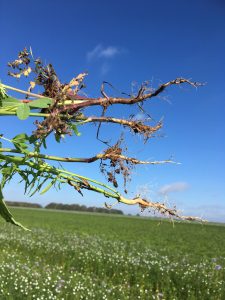 Root growth is good as you can see from the picture, scouring the soil for left over nutrient from the previous crop, and providing habitat for the all important mycorrhyzal fungi which connect root to soil. This has been an interesting experiment for us this year. Usually we leave our wheat stubbles bare over winter, but these days the word is that this is not best for soil and environment, so we are trying a new approach, in preparation for the new world which is shaping up ahead of us in the form of the Agriculture bill, which is the first new major legislation for agriculture since 1943. Farmers are naturally nervous, especially as all the talk is of public goods, with not much mention of food. Excuse me for asking but is not food a public good? Even a public right?
Root growth is good as you can see from the picture, scouring the soil for left over nutrient from the previous crop, and providing habitat for the all important mycorrhyzal fungi which connect root to soil. This has been an interesting experiment for us this year. Usually we leave our wheat stubbles bare over winter, but these days the word is that this is not best for soil and environment, so we are trying a new approach, in preparation for the new world which is shaping up ahead of us in the form of the Agriculture bill, which is the first new major legislation for agriculture since 1943. Farmers are naturally nervous, especially as all the talk is of public goods, with not much mention of food. Excuse me for asking but is not food a public good? Even a public right?
In the early spring we will have to demolish this thick crop in order to establish something that will actually earn us some money, barley in this field. To be serious, it may well be that the improvement to the soil by this crop will pay us back in the end, when the plants decompose and feed the growing barley next year, and maybe there will be more worms as a result, which add fertility to the soil by their burrowing activities. We spent £25 per hectare on seed, plus a few more pounds to sow it and roll it, wondering if this good establishment might mean that we can reduce the seed rate next year, and still get a similar result.
Our autumn sown crops of wheat and barley have shot out of the ground in the warm and moist soils, and look lovely in neat rows. We have applied a weedkiller to all, and an insecticide to control aphid which can carry barley yellow dwarf virus, which every few years will decimate our winter crops if not controlled. We can’t actually do anything against the virus, so we have to try to control the vector, various species of aphid (greenfly). The aphid blow into the crops on the wind, especially the prevailing south westerlies, from woodland and hedgerows. We have been asked to participate in a trial being run by the Game and Wildlife Conservation trust, whereby sticky traps are placed strategically in 5 fields around the farm. In each field, one trap is placed 5 metres from the hedge, and one is 70 m out into the field. 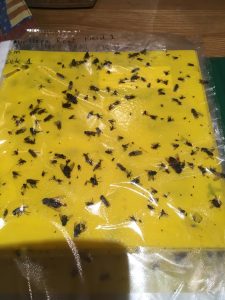 Once a week for five weeks I have to collect the traps and count how many aphids are stuck to them. From this a picture of aphid activity can be built up. The purpose of the trial is to develop a farmer friendly method for tracking aphid build up, to help us with decision making regarding insecticide applications. There is clearly no point in spraying if there are no aphid present. There is a tendency to want to spray too often, because of the fear of unseen attack, but we do need to get the sprayer out promptly if there has been a wave of infestation. Hopefully a clearly devised system using sticky traps will give us the information we need. Currently it seems to be impossible to change the traps without getting the very sticky trap glue all over your hands.
Once a week for five weeks I have to collect the traps and count how many aphids are stuck to them. From this a picture of aphid activity can be built up. The purpose of the trial is to develop a farmer friendly method for tracking aphid build up, to help us with decision making regarding insecticide applications. There is clearly no point in spraying if there are no aphid present. There is a tendency to want to spray too often, because of the fear of unseen attack, but we do need to get the sprayer out promptly if there has been a wave of infestation. Hopefully a clearly devised system using sticky traps will give us the information we need. Currently it seems to be impossible to change the traps without getting the very sticky trap glue all over your hands.
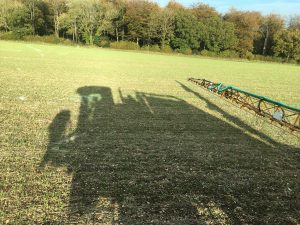
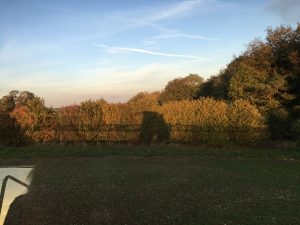 Long shadows whilst spraying in the afternoon sunshine.
Long shadows whilst spraying in the afternoon sunshine.
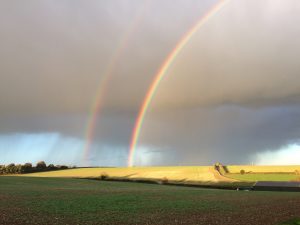 A beautiful rainbow minutes before we got soaked.
A beautiful rainbow minutes before we got soaked.
The weather recently has given us plenty of wonderful photo opportunities.
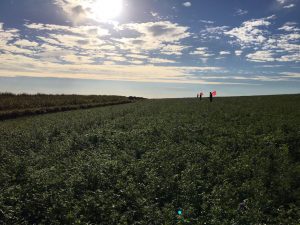 Red flags in the morning, pheasants’warning.
Red flags in the morning, pheasants’warning.
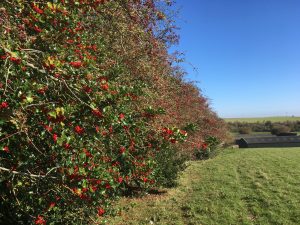 The hedgerows are laden with berries, the birds’ larder is full to overflowing. It breaks my heart to see so many hedges around the country flailed too early in the autumn, denuded of their fruit and leaves.
The hedgerows are laden with berries, the birds’ larder is full to overflowing. It breaks my heart to see so many hedges around the country flailed too early in the autumn, denuded of their fruit and leaves.
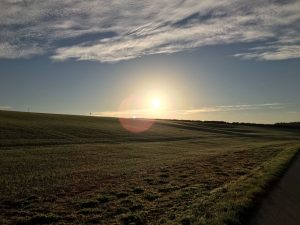 At the end of autumn sowing campaign, we have a look over our key machines, and try to get important repair jobs done before putting them away for the winter. Here is Gary trying to fit new rolls onto a shaft which seems to be 3 inches too short. Some clever work with a jack, a grain bucket and the stanchions of the tractor shed managed to get it put together in the end.
At the end of autumn sowing campaign, we have a look over our key machines, and try to get important repair jobs done before putting them away for the winter. Here is Gary trying to fit new rolls onto a shaft which seems to be 3 inches too short. Some clever work with a jack, a grain bucket and the stanchions of the tractor shed managed to get it put together in the end.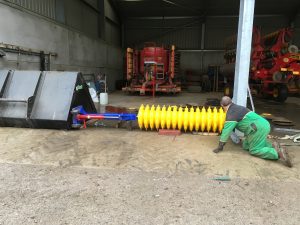
Here is some land, not on our farm I hasten to add, which has been abandoned from farming, it now features scrubby grass and patches of brambles. George Monbiot says he is in favour of re-wilding much of UK farmland, this is what you would get after a couple of years. From here the brambles will grow larger and take over, and gradually small shrubs and trees would establish. The ecological definition of this process can be described as follows:
‘The stages of primary succession include pioneer plants (lichens and mosses), grassy stage, smaller shrubs, and trees. Animals begin to return when there is food there for them to eat. When it is a fully functioning ecosystem, it has reached the climax community stage.’
Thus the likely result if left untouched by man, will be forest. Environmentally this is an attractive prospect perhaps, but leaves me wondering where our food will come from. Perhaps brexit will allow us access to cheap low grade food produced in more delicate environments overseas, leaving our farmers with nothing to do. We are blessed with fertile soils and plenty of rainfall in most of the UK, we can produce more food per hectare than most other countries in the world. It seems wasteful to squander this good fortune and to risk damaging valuable habitat overseas, not to mention the burning of the fuel that will be needed to bring it here.
There is quite a debate raging about whether farm animals are causing global warming. The vegan lobby has become quite aggressive, and is trying to make meat eating a thing of the past. It is worth considering for a moment where a vegan diet has to be sourced from. Most of the protein for such a diet has to come from nuts, soya, lentils, chickpeas, spelt and others, most of which will only grow in a climate warmer than ours.
The UK is particularly well suited to growing grass, some two thirds of its farmed area is down to grass, much of which is permanent and cannot be used for growing any other crop. The only way we can derive use for humans from this is through grazing it with animals, and consuming the product of the animals. Meat and dairy are a very important source of protein for humans.
If one is serious about saving the earth, then it is a bit of an eye-opener to consider the following:
For some of these items it is a bit late…….
last month Have a look at 10 years ago this month next month

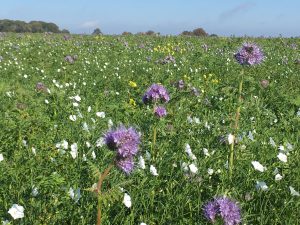
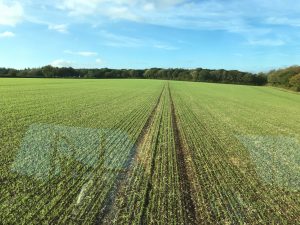
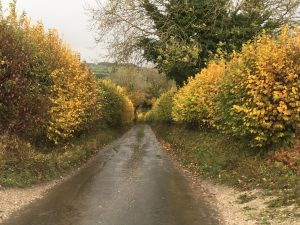
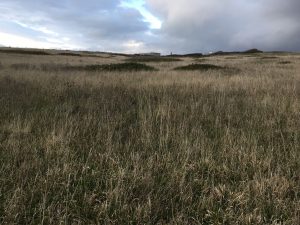
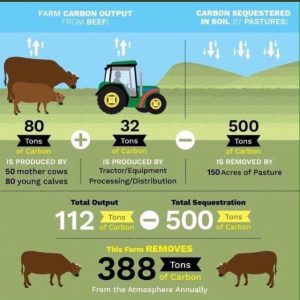
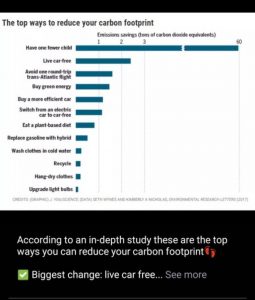
How are you going to get rid of that over wintering cover crop. Go back to ploughing to bury it, graze it off, spray off and surface till?
I noted your heartfelt comments on the premature cutting of hedgerows thankfully not too present in Dorset. In Lancashire they seem to be cut from the end of August…Yes August would you believe. My heart too was broken for 30 years and nothing I could say or do made any difference. Why are we losing so many birds….well that’s why! kind Regards